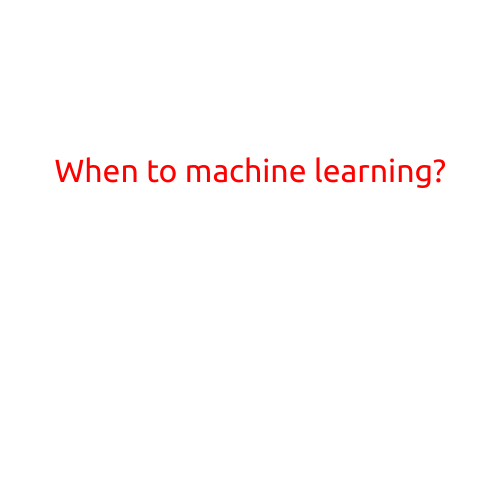
When to Use Machine Learning?
Machine learning has become a buzzword in the tech industry, with many organizations considering it as a key component of their digital transformation strategy. However, before diving headfirst into developing a machine learning model, it’s essential to ask yourself when machine learning is the right solution for your problem.
In this article, we’ll explore the scenarios where machine learning is likely to be the best approach and when you might want to consider alternative solutions.
When Machine Learning is a Good Fit
- Handling Complex, Unstructured Data: Machine learning is particularly effective when dealing with large datasets that are complex, unstructured, or difficult to analyze using traditional methods. This includes tasks such as image recognition, natural language processing, and recommender systems.
- Identifying Patterns and Relationships: Machine learning algorithms are designed to identify patterns and relationships within data that may not be immediately apparent to human analysts. This makes it an excellent choice for tasks such as predictive modeling, anomaly detection, and clustering.
- Modeling Human Decisions: Machine learning can be used to model human decision-making processes, allowing you to train models on historical data and use them to make predictions or recommendations.
- Scale and Performance: Machine learning models can be designed to handle large volumes of data and scale to meet the demands of high-traffic applications.
When to Consider Alternative Solutions
- Simple, Well-Structured Data: If you have a small dataset with a simple structure, you may be able to achieve the same results using traditional analytics techniques, such as SQL queries or statistical modeling.
- Domain Knowledge: If the problem you’re trying to solve requires significant domain knowledge or expertise, you may want to consider alternative solutions that leverage human intuition and judgment.
- Limited Training Data: If you have limited training data, machine learning may not be the best approach, as models require a significant amount of data to learn from.
- Real-Time Processing: If you need to process data in real-time, machine learning may not be the best choice, as it typically involves computationally-intensive processing and may not be suitable for low-latency applications.
Conclusion
Machine learning is a powerful tool that can be applied to a wide range of problems. However, it’s essential to carefully consider the scenario and ask when machine learning is the right solution for your problem. By understanding the strengths and weaknesses of machine learning, you can ensure that you’re using the right tool for the job and achieving the best possible results.
Key Takeaways
- Machine learning is a good fit for handling complex, unstructured data, identifying patterns and relationships, modeling human decisions, and scale and performance.
- Consider alternative solutions, such as traditional analytics techniques or human intuition, when dealing with simple, well-structured data, requiring domain knowledge, limited training data, or real-time processing.
By following these guidelines, you’ll be well on your way to making informed decisions about when to use machine learning and when to consider alternative solutions.





